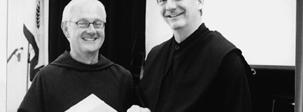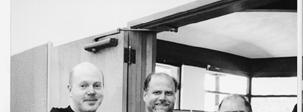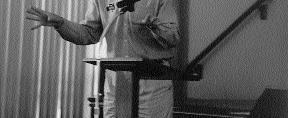
4 minute read
Benedictine Letter
Woodside Priory’s Brother Edward Englund, left, coordinated the colloquium. Father Gregory Mohrman, of St. Louis Priory School in Missouri, summed up the colloquium proceedings with his presentation, “Where Do We Go From Here?” When people think of the way their communities are organized, they often picture the leaders as “out in front,” turned around so they can talk to all the nonleaders. A better contemporary model might be everyone standing together, facing the same direction in his or her common search for God, Father Gregory proposed. That model emphasizes the role of everyone, leader and non-leader, in defining each Benedictine community.



Benedictine Leaders Seek To Define Schools of The New Century
Benedictine educators from the United States, England and Mexico met at Woodside Priory School in Portola Valley August 2-6 to share information and discuss common issues. This is a relatively new concept for Benedictines, an order which has a history of working as small, individual, selfsupporting communities.
Two general issues dominated most of the five-day conference: encouraging faculty to define and practice Benedictine values, and dealing with the continuing decline of monastics to carry on the traditions.
The forty-plus conference members participated in round-table discussions and “knowledge cafes” - topical breakout sessions led by members with experiences to share.
In an opening address, Father David Pettigill, head of pastoral services in the San Francisco Archdiocese, cited the need for leaders to discover God’s overarching plan, rather than impose their own. The plan is discernable by using scripture to interpret what one observes in daily life, he said.
“The church leader’s role is to (identify,) name and celebrate what’s happening, not to control it,” he said.
Sister Mary Claire Buthod, of St. Joseph’s Monastery in Oklahoma, and her colleague, Sister Jacinta Dorado, spoke to the Benedictine concern for respecting individual differences.
Their school has developed a program of support for capable students with learning differences that allows them to succeed with children who formerly would have been asked to leave, Sister Mary Clare told the group.
Their program asks the student and his/her teachers and parents to define a wide variety of strengths and weaknesses. With the help of a specialist, the team administrator develops a plan that recognizes both. Sister Jacinta follows up individually with each child’s teachers and meets monthly with everyone, she said.
Parents and faculty who initially had concerns about watering down the school’s high academic standards now are 100% supportive, said Sr. Jacinta.
Father Christopher Jamison, Worth Abbey, England, described the “inspiring success” of Collegio San Emerico in Sao Paulo Brazil - a large K-12 school based on St. Benedict’s rule but run entirely by lay men and women. All of the students practice, in age-appropriate and contemporary ways, the daily routine set forth in St. Benedict’s Rule, he said.
A small group of schools from Brazil, Chile, the United States and England, have begun a small support network that could be a model for other schools - especially those seeing the value of a multi-national perspective, he said.
4
Father Luke Travers, left, from Delbarton School in New Jersey, and Father Philip Davey, from St. Bede Academy in Illinois, enjoy the







What does a Benedictine education offer for the new millennium?
An opportunity to develop the power of a supportive community that shares responsibility.
A chance to live in a community that respects all its members, with all their differences.
Practice in listening, and finding, God’s guidance in the modern world.
Rigorous academics that exercise all aspects of human intelligence.
Attention to maintaining a balanced life with rhythm and purpose.
Values, knowledge and training that are forward-looking, with an eye to the rewards and challenges ahead.
Summary from the Third Benedictine Colloquium chance to reunite with a friend, Headmaster Tim Molak. Sister Jacinto Dorado, left, and Sister Mary Claire Buthod, right, earned a standing ovation for their presentation on supporting students with learning differences. They are from St. Joseph’s Monastery in Oklahoma; here, they join Sister Bridget Dickerson from Mt. St. Scholastica in Kansas.
Woodside Priory School August 2000


Father Christopher Jamison, from Worth Abbey, described the success of a small sub-community of schools - four from three countries - that are learning to support each other.



Monica Judd, left, Victoria Galindo, center, and Gabriela Perlasca, attended from Colegio Guadalupe in Mexico. Theirs is one of a growing number of schools practicing the Benedictine Rule without any monastic faculty. Other schools have a different problem - many monastics live on the campus grounds but have retired and withdrawn from
campus life.



